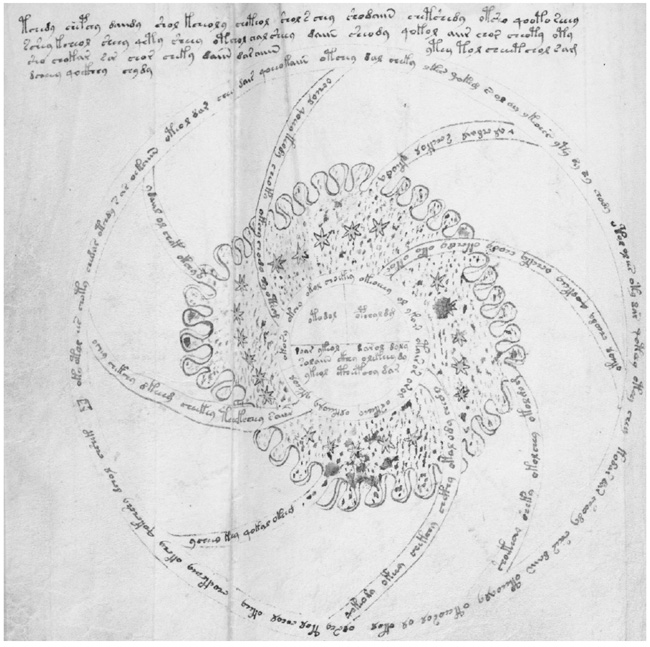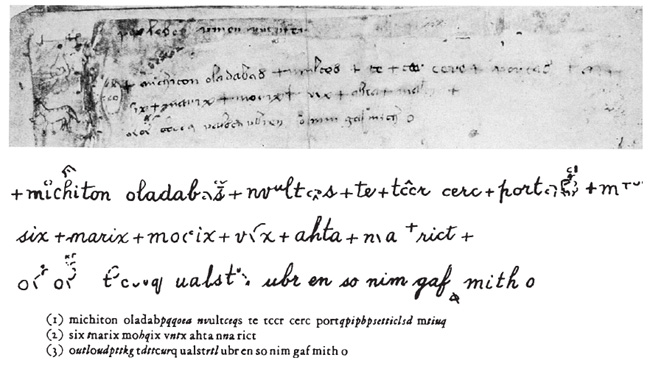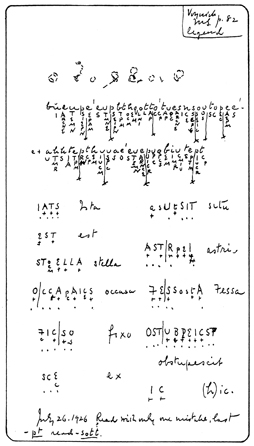The Friar and the Cipher (22 page)

In the mind and spirit of Anathasius Kircher, mysticism, religion, and scientific curiosity held their last great collaboration. Born in eastern Germany on May 2, 1602, the feast day of his namesake, Kircher was the last of nine children. His father, Johann, was an educated man, a doctor of divinity who taught scripture at the local Benedictine monastery. Johann possessed a large private library and a questing, unorthodox mind, as evidenced by his decision to have his son, who attended Jesuit school, also trained in Hebrew by a rabbi.
Kircher would later write his life's story,
Vita admodum Reverend: P.A. Kircheri
, in which he detailed an eventful childhood. On one occasion, he went swimming in the mill pond with his friends and was swept up in the waterwheel; on another, he was pushed out onto the track in the middle of a horse race with the riders bearing down on him; still later, he caught a chilblain while skating, which turned septic, but he prayed ardently to the Virgin Mary and was cured overnight. These adventures did not end with puberty. During the Thirty Years' War he escaped an oncoming Protestant army by fleeing across the Rhine on an ice floe and narrowly escaped execution when he refused to shed his Jesuit robes and travel in lay attire. He tramped into the very heart of Mount Vesuvius and got lava on his sandals; he was robbed by pirates and shipwrecked in out-of-the-way places.
Because of these miraculous escapes, Kircher concluded that he had been singled out by God for great works. Naturally curious, he threw himself into scientific study. He acquired a telescope and observed sunspots. He dabbled in magnetism and optics. During his lifetime he would produce more than forty treatises on everything from the subterranean world to the cosmos.

Anathasius Kircher
BEINECKE RARE BOOK AND MANUSCRIPT LIBRARY
,
YALE UNIVERSITY
His knowledge of antiquity allowed him to re-create Noah's Ark and the Tower of Babel in such mathematical detail that he was able to assert that the former measured precisely fifteen cubits and to debunk the theory that the latter was tall enough to reach to the moon. Based on reports from Jesuit missionaries in Asia, he wrote about Chinese calligraphy and exotic fruits like the pineapple, which he claimed could devour iron nails. He spent an enormous amount of time translating (incorrectly, as it turned out) and explaining the significance of Egyptian hieroglyphics. He was a student of John Dee's work and commented on it extensively. Whereas Dee had seen mathematics as the key to God and divine knowledge, Kircher believed light and magnetism to be evidence of divine truth. Also like Dee, Kircher was suspected of practicing the dark arts when the theatrical effects he had staged to entertain the archbishop of Mainz one evening—he also imitated flight with ropes and pulleys—turned out to be a little too realistic for his credulous audience.
A devout Jesuit, Kircher passed all of his accumulated knowledge through the filter of the teachings of St. Ignatius of Loyola. He continually searched for, and found evidence of, the Trinity in nature. All of the ancient cultures and religions he studied were also found to be in the Christian mold; scriptural significance was hidden in pagan symbols and allegories.
His talents were noticed by his superiors. Powerful Church patrons backed him, and he was awarded the chair in mathematics at the Collegio Romano. His arrival in 1635 could not have been timelier. The brilliant and popular Tuscan Galileo Galilei had recently been condemned to imprisonment by the Inquisition for publicly stating the Copernican notion that the earth went around the sun, and the Church desperately needed a champion with unimpeachable scientific credentials who would defend a strict scriptural interpretation of the heavens.
With Kircher, the Church made one last attempt to coopt science and subordinate it to faith. Kircher was a skilled showman. He dazzled the local peasantry with huge, dragon-shaped hot air balloons and beams of light that shot out of specially designed mirrors, and scared them silly with a magic lantern show about the flames of hell devouring a wicked soul. At Christmas, he set up a nativity scene complete with spotlights. But Kircher never questioned scriptural supremacy. Rather, he defended the Church's position: “Whosoever glorifies the dignity of the name of Christ, let him be especially careful not to philosophize beyond the limits of sacred canonical proscriptions,” he wrote.
This was not hypocrisy. Kircher apparently resolved the centuries-old conflicting drives of faith and science by patching them together with the familiar John Dee form of spiritual mysticism. There is some evidence that he might have believed in the Copernican system but did not admit it publicly. Whenever he wanted to float an idea contrary to scripture, he said he had a dream. One could not be imprisoned or censured for dreams. As a result, “writing in support of a theological perspective that found great support among various Catholic rulers, Kircher enjoyed the privileged position of publicizing and elaborating a philosophy that was, in essence, the official position of the baroque church,” the Stanford historian Paula Findlen concluded.
In fact, Kircher was the end of that line of mysticism that had embraced John Dee and the myth of Roger Bacon, which had had its heyday in the alchemy of the court of Emperor Rudolph. He was magnificent, flamboyant, spellbinding, and prolific. But he was also the Church's man, doomed to watch the great rolling ocean of scientific advancement wash over him, as a shell on the beach, before it finally ground him down to sand. For all the façade of mathematics and prolific knowledge, Kircher's science—when it was not outright fiction—was wishful, not empirical. The Royal Society could not confirm any of his results.
Isaac Newton, although much less well known, was already at work on his
Philosophia Naturalis Principia Mathematica
when Kircher died in 1680. Its publication seven years later sounded the death knell for those who still clung to the Bible as the literal source of all knowledge. The experimental science first formulated by Roger Bacon in his
Opus Majus
had finally come into its own.
AFTER KIRCHER'S DEATH,
all of the curiosities in his
Musaeum,
carefully cataloged, became the property of the Jesuits in Rome. The cipher manuscript was never listed among his effects. Still, when Wilfrid Voynich pored through the chest containing the manuscripts of Pierre-Jean Beckx, 22nd General of the Jesuit Order, at Villa Mondragone 250 years later, there it was.
CHAPTER SEVENTEEN
The Making of the Most Mysterious
Manuscript in the World
• • •
WHEN WILLIAM ROMAINE NEWBOLD CONFIRMED
Wilfrid Voynich's suspicion that the author of the cipher manuscript was Roger Bacon, it caused a sensation throughout the bibliographic and scientific communities. But Newbold had just gotten started. Two years later, on April 20, 1921, after enormous fanfare (generated largely by Voynich), Newbold presented a paper to an audience of top-level scientists and cryptanalysts at a meeting of the American Philosophical Society, where he announced his truly momentous achievement—he had cracked the primary code.
The results were astonishing. Although Newbold had been able to transcribe only about four percent of the cipher, it was apparent that this manuscript was perhaps the most important scientific document ever uncovered.
Within these encrypted pages lay knowledge centuries before its time, and in a fantastic array of scientific disciplines. According to Newbold's transcription, Roger Bacon had not only predicted the microscope and the telescope, but built them. Through his telescope, Bacon had viewed the Andromeda Nebula (illustrated in the manuscript), and, through the microscope, spermatozoa and a fertilized ovum (also with illustrations). He had predicted and described a solar eclipse in 1290, discussed steam power, dated a comet that appeared in 1273, described riots at Oxford between knights and ecclesiastics, also in 1273 (in which he played a decisive role, dispersing the crowd with an explosion of gunpowder), and detailed a process for refining copper ore.

Voynich manuscript illustration of the Andromeda Nebula as interpreted by Newbold
BEINECKE RARE BOOK AND MANUSCRIPT LIBRARY, YALE UNIVERSITY
Before he went into what was admittedly a circuitous method of encryption, Newbold assured his audience that he had no knowledge of chemistry and that he had been unaware of either the Andromeda Nebula or the Oxford riots. This, he claimed, was proof that he had not force-fit the transcription into a predetermined solution and that what he had found in the manuscript must be genuine.
The cipher itself was almost impossibly complex, six layers in all, although each of the layers had been described by Bacon in his letter of 1248. Newbold began with the Latin text on the last page, the first line of which read, “michiton oladabas multos te tccr cerc portas.” Eliminating what he first assumed were nulls, Newbold came up with “michi dabas multos portas,” which he translated as “thou hast given me many gates,” although “multos” should have been spelled “multas.” Aware that Bacon was well versed in the Kaballah, Newbold then assumed that “gates” referred to the convention in Kaballah that meant letter pairs, and so deduced that individual plaintext letters were represented by two adjacent letters in the ciphertext.
That got him closer, but he was still unable to make sense of the manuscript. Returning to the key and looking more closely at the individual letters, especially the
o
in “multos,” Newbold noticed that what appeared to be an
o
written with flourishes was actually a symbol fashioned from three individual pen strokes. Each of these was highly reminiscent of a symbol in Greek shorthand with which Bacon had been familiar. Remembering that Bacon had praised shorthand as the best way of obscuring secrets, Newbold studied the shorthand, and patterns began to emerge.
Soon he had his alphabet—a substitution transcription of Latin letters, punctuation, and other symbols, based on frequency and position of the Voynich characters—but even then he was not yet home. Bacon, he claimed, had further hidden his true meaning in anagrams. The first confirmation occurred when he applied this alphabet to the discarded nulls in the key and came up with “R Baconi.”

Newbold's last completed worksheet reprinted in
The Cipher of Roger Bacon
by William R. Newbold
Had this pronouncement come from someone with lesser credentials than the Adam Seybert Professor of Intellectual and Moral Philosophy at the University of Pennsylvania, a man who had received only the second Ph.D. the university had ever granted in philosophy, a former dean of the graduate school, a scholar of soaring reputation and unimpeachable credentials—he was to be acknowledged the very next year by Theodore Roosevelt, Jr., for his code breaking for the navy—the members of the audience might have scoffed. As it was, none did.

Newbold's “key” worksheet reprinted in
The Cipher of Roger Bacon
by William R. Newbold
Major newspapers and magazines across America reported the great discovery—the
New York Times
headline proclaimed, “Bacon 700 Years Ahead in Science.” Both Newbold and Bacon burst from the cloistered confines of medieval scholarship into the popular arena and became instant celebrities. As David Kahn noted in
The Codebreakers
, “Sunday supplements had a field day.” Even the Catholic Church jumped on board, willing to let bygones be bygones. Two separate articles in
Catholic World
lauded Bacon's achievements and proclaimed them testaments to the power of thirteenth-century scholasticism.
Later, Bacon was even featured in a short story by Rudyard Kipling entitled “The Eye of Allah.” Bacon is described as “a learned and famous philosopher [who] holds his liquor too, valiantly,” and is cast as a cantankerous friar decrying the unwillingness of the Church to encourage scientific experiment. The “eye of Allah” itself is a lens that Bacon wants to use for scientific purposes, but he is thwarted by more conservative and superstitious colleagues. The future Pope Clement and Peter Peregrinus make cameo appearances.
With Bacon's newfound popularity, cryptography itself became a fad, and code breaking a public fascination as never before. But the drama was just beginning. Even as Newbold returned to the manuscript to try to complete the transcription, nagging questions began to arise.
Scientific American
found the solution tortured and said that Newbold seemed to have described a one-way cipher—one that could be decrypted from code text to plaintext but not encrypted the other way around (although a different article in the same publication lauded both Newbold's conclusions and his scholarship).
In 1923, a history professor at Western Reserve University named Lynn Thorndike published a two-volume work entitled
A History of Magic and Experimental Science
. Thorndike had been working on this study for twenty years—he would add six more volumes, the last of which would be published in 1958—and it was so extraordinarily researched that he had unearthed documents in the Vatican Library that the librarians did not know they had. For all the detail, however—and Thorndike covered
everyone
—the longest single section was devoted to Roger Bacon, “who,” he wrote, “in modern times has received so much attention and admiration at the expense of contemporaries and his age. Happily in the present volume we are in a better position to estimate him fairly.” Then, caustically and with extremely selective use of data, he dismissed Roger Bacon as a minor figure in the history of science, vastly overrated and with no original work to his credit.
Debunking Bacon had become something of a crusade for Thorndike. Throughout the previous decade he had written articles in which he tried to diminish Bacon's achievements and paint him as a crank or mystic. What others had described as courage, Thorndike painted as stubbornness. Conviction became spite, persistence became jealousy. Thorndike's prejudice toward the Dominicans was palpable. He ridiculed Bacon for his belief in spirits and monsters but neglected to mention that Albert was every bit as superstitious, and Thomas even more so. Nowhere in Thorndike's work, for example, can one find Aquinas's conviction that wind storms were sent by a vexed God to discipline man. In
A History of Magic and Experimental Science,
Thorndike did not mention Newbold or the Voynich manuscript specifically but did include a scathing critique of Colonel Hime's assertion that Bacon had employed an Argyle cipher to disguise the formula for gunpowder.
Still, through the 1920s, Thorndike and
Scientific American
notwithstanding, most scholars continued to find Newbold's work brilliant and ingenious and his conclusions persuasive. Newbold won his greatest victory two months after his presentation when, in the July 1921 issue of
Harper's Magazine
, John Matthews Manly, who had been second in command of MI-8, wrote an article tentatively accepting both his methods and his conclusion. Manly had been one of the cryptanalysts who had failed to crack the cipher in the years immediately after Voynich acquired it. He had been a highly respected scholar before the war and afterward had returned to the University of Chicago to become chairman of the English department. Manly was the same age as Newbold (and Voynich) and had known and become friends with Newbold during the war.
The article also contained a compelling argument for the manuscript's authenticity. “It does not seem possible,” Manly wrote, “to doubt that this is a real cipher, based upon a real language. No man in any century previous to the sixteenth could ‘fake' a cipher system that possessed so many marks of genuineness as this and carry it consistently through nearly three hundred pages of closely written text.” As to Newbold's esoteric assertion that the pen strokes in the key indicated shorthand, Manly added, “It would be easily possible to incorporate [Newbold's] microscopic signs into the strokes forming these symbols without in any way producing interference or difficulty.”
With Manly on his side, Newbold had little to fear from the far less celebrated Thorndike.
As great a coup for Newbold as the
Harper's
article was, everyone in the field wondered whether Manly's old boss at MI-8, Herbert Osborne Yardley, who had also taken an interest in the manuscript but failed to crack the code, would weigh in as well.
Yardley, an inaugural member of the Hall of Honor at the National Security Agency's Cryptologic Museum, is one of the most famous and controversial figures in the history of cryptography, and the spur of perhaps the most famous epigram about the practice. He began his career in his early twenties as a code clerk in the State Department, but after privately cracking Woodrow Wilson's own enciphered telegrams, he was granted a commission in the army. After the United States entered the war in 1917, Yardley was sent to France as a cryptanalyst, and then, still not yet thirty, made head of MI-8, where he immediately recruited Manly to run the department in Washington. When Yardley returned home after the war, he induced the army to establish a permanent unit to penetrate and monitor other countries' coded messages, a group he floridly nicknamed “The Black Chamber,” a French term for any government agency that opens and reads mail. Yardley's main objective was to track one particular nation's traffic, a country that he was convinced would soon be a threat to American security—Japan. Manly returned to the University of Chicago, but the men would remain good friends.